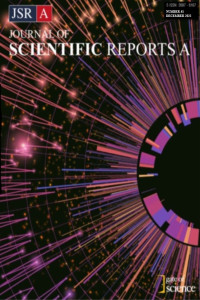Research Article
Year 2022,
Issue: 051, 120 - 126, 31.12.2022
Abstract
References
- [1] Yolcu, M. B., Emre, Ş. and Celayir, S., (2018), Artırılmış gerçekliğin tıpta ve çocuk cerrahisinde kullanımı, Çoc. Cer. Derg., 32(3), 89-92.
- [2] İçten, T. and Bal, G., (2017), Artırılmış gerçeklik teknolojisi üzerine yapılan akademik çalışmaların içerik analizi, Bilişim Teknolojiler Dergisi, 10(4), 401-415.
- [3] Özdemir, M., (2017), Artırılmış gerçeklik teknolojisi ile öğrenmeye yönelik deneysel çalışmalar: Sistematik bir inceleme, Mersin Üniversitesi Eğitim Fakültesi Dergisi, 13(2), 609-632.
- [4] Küçük, S., Kapakin, S. and Göktaş, Y., (2015), Tıp fakültesi öğrencilerinin mobil artırılmış gerçeklikle anatomi öğrenimine yönelik görüşleri, Yükseköğretim ve Bilim Dergisi, 3, 316-323.
- [5] Akkuş, İ. and Özhan, U., (2017), Matematik ve geometri eğitiminde artırılmış gerçeklik uygulamaları, Inonu University Journal of the Graduate School of Education, 4(8), 19-31.
- [6] Çakal, M.A. and Eymirli, E., (2012), Artırılmış gerçeklik teknolojisi, Kuzeydoğu Anadolu Kalkınma Ajansı, 1, 1-10.
- [7] Çiloğlu, T., Yılmaz, Ö., Yılmaz, A. and Yılmaz, F. G., (2021), Eğitimde artırılmış gerçeklik konulu makalelerin incelenmesi, Ahmet Keleşoğlu Eğitim Fakültesi Dergisi, 3(2), 147-158.
- [8] Chang, H., Binali, T., Liang J., Chiou, G., Cheng, K., Lee, S., and Tsai, C., (2022), Ten years of augmented reality in education: A meta-analysis of (quasi-) experimental studies to investigate the impact, Computer & Education, 191, 10641.
- [9] Kok, D., Dushyanthen, S., Peters G., Sapkaroski, D., Barrett, M., Sim, J., and Eriksen, J.G., (2022), Virtual reality and augmented reality in radiation oncology education - A review and expert commentary, Technical Innovations & Patient Support in Radiation Oncology 24, 25-31.
Year 2022,
Issue: 051, 120 - 126, 31.12.2022
Abstract
In recent years, it has been possible to prepare very important studies in the field of education by using Augmented Reality technology. With this technology, video, graphics, sound and three-dimensional models are used in the environment of physical objects in the real world. Today, Augmented Reality technology is used in industry, education, medicine, logistics, industry, etc. are frequently used in the fields. Therefore, due to the development of applications in this field, technological devices have been enabled to communicate with their environment and acquire new information. In this study, an application has been developed to help disabled individuals understand the functions of their brain functions and to improve their learning abilities. In the application, the functions of brain functions are explained, thanks to the content activated with the help of a button that appears on the screen on any technological device. If a visually impaired person uses this application, brain functions are explained only with audio narration and animations. If a hearing-impaired individual uses it, brain functions are explained only with texts and animations. In this way, the learning abilities of the disabled are improved more easily and it is easier to understand the subjects.
Keywords
Thanks
This research received no specific grants from any funding agency in public, commercial or non-profit sectors.
References
- [1] Yolcu, M. B., Emre, Ş. and Celayir, S., (2018), Artırılmış gerçekliğin tıpta ve çocuk cerrahisinde kullanımı, Çoc. Cer. Derg., 32(3), 89-92.
- [2] İçten, T. and Bal, G., (2017), Artırılmış gerçeklik teknolojisi üzerine yapılan akademik çalışmaların içerik analizi, Bilişim Teknolojiler Dergisi, 10(4), 401-415.
- [3] Özdemir, M., (2017), Artırılmış gerçeklik teknolojisi ile öğrenmeye yönelik deneysel çalışmalar: Sistematik bir inceleme, Mersin Üniversitesi Eğitim Fakültesi Dergisi, 13(2), 609-632.
- [4] Küçük, S., Kapakin, S. and Göktaş, Y., (2015), Tıp fakültesi öğrencilerinin mobil artırılmış gerçeklikle anatomi öğrenimine yönelik görüşleri, Yükseköğretim ve Bilim Dergisi, 3, 316-323.
- [5] Akkuş, İ. and Özhan, U., (2017), Matematik ve geometri eğitiminde artırılmış gerçeklik uygulamaları, Inonu University Journal of the Graduate School of Education, 4(8), 19-31.
- [6] Çakal, M.A. and Eymirli, E., (2012), Artırılmış gerçeklik teknolojisi, Kuzeydoğu Anadolu Kalkınma Ajansı, 1, 1-10.
- [7] Çiloğlu, T., Yılmaz, Ö., Yılmaz, A. and Yılmaz, F. G., (2021), Eğitimde artırılmış gerçeklik konulu makalelerin incelenmesi, Ahmet Keleşoğlu Eğitim Fakültesi Dergisi, 3(2), 147-158.
- [8] Chang, H., Binali, T., Liang J., Chiou, G., Cheng, K., Lee, S., and Tsai, C., (2022), Ten years of augmented reality in education: A meta-analysis of (quasi-) experimental studies to investigate the impact, Computer & Education, 191, 10641.
- [9] Kok, D., Dushyanthen, S., Peters G., Sapkaroski, D., Barrett, M., Sim, J., and Eriksen, J.G., (2022), Virtual reality and augmented reality in radiation oncology education - A review and expert commentary, Technical Innovations & Patient Support in Radiation Oncology 24, 25-31.
There are 9 citations in total.
Details
| Primary Language | English |
|---|---|
| Subjects | Engineering |
| Journal Section | Research Articles |
| Authors | |
| Publication Date | December 31, 2022 |
| Submission Date | June 15, 2022 |
| Published in Issue | Year 2022 Issue: 051 |


